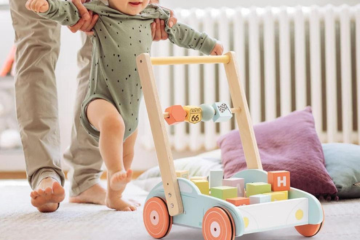
Choosing the Best Baby Walker for Your Little One: Is a Wooden Walker a Good Option?
Share

Choosing the Best Baby Walker for Your Little One: Is a Wooden Walker a Good Option?
When your baby reaches the stage of wanting to explore and practice walking, a baby walker can be a helpful tool. However, with many types of walkers on the market, choosing the right one can be challenging. Let’s break down the different types of baby walkers and explore whether a wooden walker is a good choice for your baby.
1. Types of Baby Walkers
1.1. Traditional Walkers: Traditional walkers are designed with a frame and wheels that allow your baby to walk while being supported by the walker. They typically feature a seat with a harness and a tray for toys. These walkers can be adjustable in height and often come with various entertainment features. However, safety concerns with traditional walkers include the risk of tip-overs and access to dangerous areas.
1.2. Activity Walkers: Activity walkers are similar to traditional walkers but come with interactive toys and activities. These walkers can engage your baby with music, lights, and textures, which can be stimulating and educational. They also usually have a larger base for better stability.
1.3. Push Walkers: Push walkers are designed to be pushed from behind. They often resemble small carts or toys and help your baby practice walking while providing support. Push walkers promote better balance and coordination compared to traditional walkers, as they encourage your baby to use their legs and arms.
1.4. Wooden Walkers: Wooden walkers are a more traditional option and are often praised for their durability and aesthetic appeal. They come in various designs, including simple push walkers and those with built-in toys. Wooden walkers are generally considered safer because they are less likely to tip over and often have a sturdy construction.
2. Is a Wooden Walker Good for Your Baby?
**2.1. Pros of Wooden Walkers:
- Durability: Wooden walkers are robust and can withstand rough use.
- Stability: They provide a stable base, reducing the risk of tipping over.
- Eco-Friendly: Made from natural materials, wooden walkers are an environmentally friendly choice.
- Aesthetic Appeal: Wooden walkers often have a classic and stylish design.
**2.2. Cons of Wooden Walkers:
- Limited Features: Wooden walkers might not have the interactive toys and features found in plastic or activity walkers.
- Weight: They can be heavier than plastic models, which might affect portability and ease of use.
3. What to Look for in a Baby Walker
Regardless of the type, there are essential features to consider when choosing a baby walker:
- Safety: Ensure the walker has a wide base for stability and check for any safety certifications. Avoid walkers with sharp edges or small parts that could be a choking hazard.
- Adjustability: The walker should have adjustable height settings to accommodate your baby’s growth.
- Ease of Use: Look for a walker that is easy to assemble and maneuver.
- Comfort: The seat should be comfortable and supportive, with a harness to keep your baby secure.
Conclusion
Selecting the right baby walker involves balancing safety, functionality, and style. Wooden walkers are a great option if you’re looking for durability and classic design, while activity and push walkers offer interactive features and developmental benefits. Whichever type you choose, ensure it meets safety standards and suits your baby’s developmental stage. For a timeless and sturdy choice, consider investing in a high-quality wooden walker that will support your baby’s journey toward walking with confidence.

